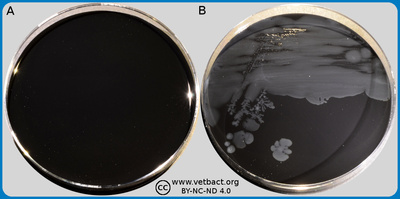CCDA (Charcoal Cefoperozone Deoxycholate agar)The figure shows two CCDA plates. No sample has has been applied onto the plate in image A. Campylobacter jejuni subsp. jejuni has been cultivated on the plate in image B. The colonies appear as greyish to white and get a metallic sheen if the plate is tilted in the light from a lamp, which can be seen on the CCDA plate on the C. jejuni subsp. jejuni page. - Click on the image to enlarge it. Image: Karl-Erik Johansson (BVF, SLU) and Lise-Lotte Fernström (BVF, SLU).
Applications:The medium, which is described here is actually a modified CCDA medium, a blood-free selective medium for isolation of Campylobacter spp. Cultivation on CCDA plates is performed at 37 or 42°C after surface spreading and incubation under a microaerophilic atmosphere in the presence of CO2 . CCDA medium contains:
The final pH of the medium should be 7.4. Other comments:Campylobacter spp. colonies are flat and round to irregular with smooth edges. On CCDA agar the colonies are often translucent and greyish-white with a metallic sheen. Colonies of some strains may spread to a continous film (svarming) on moist agar. Updated: 2019-10-09. |

